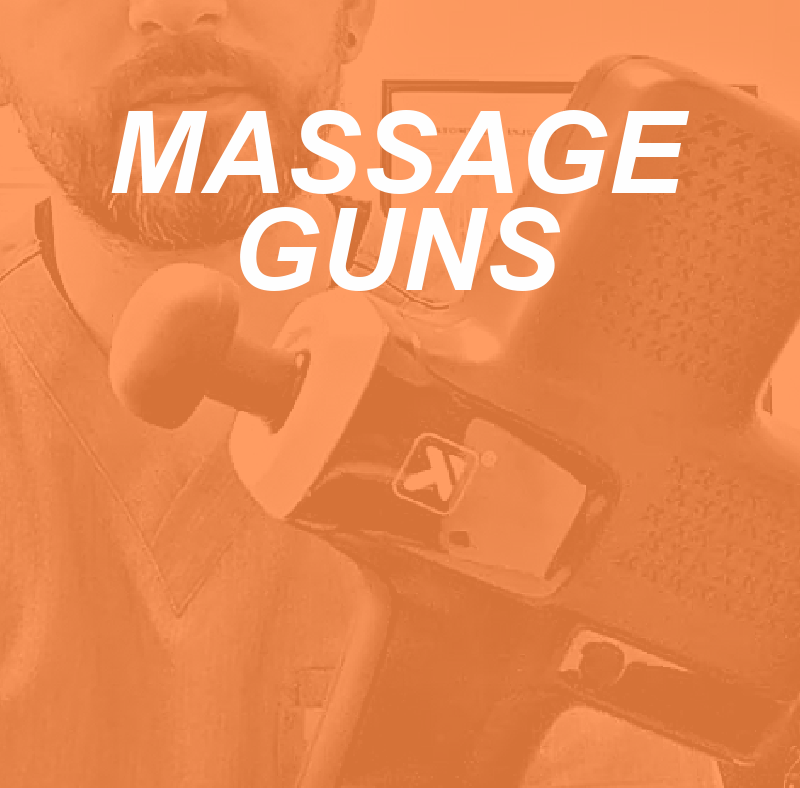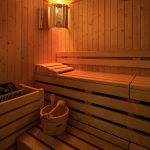
Technology is now at the disposal of all industries, and the fitness industry is no exception. Now is the time when powerfully potent percussive massage therapy is literally at our fingertips. This is a brief rundown of everything you need to know when your clients ask you, “What are your thoughts on massage guns?”
Percussive Massage Background
To my knowledge, it started back in the late ’90s with the patenting of the DMS tool. This beast was a game-changer for myofascial therapists, at least for those who could afford it. The thing was thousands of dollars. Even today, the price hovers around $3k.
When I was going through school, it seemed like only the NFL chiros and big teams had them, but a change was coming. I started noticing some very creative people building rounded rubber adaptors for run-of-the-mill jigsaws (some still haven’t really evolved past those early days). Flash forward nearly 10 years and here we are in the golden age of percussive massage, with some of the best tools on the market anywhere between $100 to $500, fully kitted, all wireless, and rechargeable.
Talking about brands, Theragun/Therabody is certainly the most visible right now with some great branding and a “Goldilocks” of price, performance, and size options. They’ve certainly worked out some of the kinks in their earlier products which tended to be noisier.
But, Hypervolt/Hyperice has been in the vibration game for a lot longer and definitely has more clout there.
Then there’s TriggerPoint, already successful with their wide collection of insanely popular self-myofascial release products, making it easy to trust their interaction on the massage gun (video below).
Pretty much every viable company is throwing their hat in the ring when it comes to percussive massage, which means a big win as the consumer.
But what exactly do they do? Why should everyone have one? Let’s do my favorite thing and break it all down.
Why Use Massage Guns?
Vibration is great for the body. Think jacuzzi jets, old footsie-wootsie machines at fairs, thumping bass at a concert, and the 70 years of use with physiotherapeutic ultrasound. They all utilize pulsing waves through the body. We know the implementation of vibration to reduce pain, promote relaxation, and improve the speed of healing. With the repeated mechanical stress of a percussive massage tool, studies have shown an improved range of motion in joints and less delayed-onset muscle soreness.
If you were looking for a financially and physically accessible therapeutic tool that you could use on yourself to help improve ROM, reduce soreness and pain, and help you relax, a massage gun might be exactly what you’re looking for.
How They Work
In my practice as a Board Certified and Licensed Chiropractor, I see a lot of mechanical issues—typically joint or soft tissue (muscle, fascia) not moving properly. I have a lot of tools to get those areas moving again: Cupping, IASTM/Graston, kinesiology tape, manual myofascial release, joint mobilizations, manual adjusting, drop table assisted adjusting…the list goes on and on, but the problems are usually the same.
A percussive massage gun is another option in the toolbelt for me, but a lot easier to use for the layperson than some of my other tools. A massage gun applied to a muscle or tight area provides a rhythmic pumping to the tissue which helps improve fluid dynamics in the region (better blood flow and lymphatic drainage). This persistent repetitive pressure also deforms tissue layers, creating more space and movement between layers – another good thing if you remember my blog on trigger points and how to address them.
If anyone asks, there’s a distinct physiological and physical/mechanical impact on your myofascial system which helps muscles warm-up, keep working, and cool down. Yes, this is an injury-prevention tool, a performance tool, and a recovery tool all in one and easily employed by anyone with a hand to hold it.
Words of Caution
As simple as one may look, a massage gun is not just a point-and-click camera. Never go over eyes, genitals, or other sensitive areas (keep out of reach of kids). Never apply over pregnant bellies, regions with cancerous cells, or areas with impaired sensation (like diabetic neuropathy).
With any tool you use, you want to know what basic assumptions you’re making…would you do strength training on a person with a dislocated joint? No – you need functional joints as a foundation for strength. In the same way, we shouldn’t be percussing areas that can’t feel the percussion, or bodies that can’t heal as well (think iron-deficiency or prone to bruising). There is such thing as too much, so if it’s painful or showing damage later, you may need to modify what you’re doing or consult a doc. To start, 30-90 seconds is a good protocol per region.
Closing Thoughts on Massage Guns
Do you need a massage gun? Yes.
Do you need to know how to use it? Yes.
Do you need an oscillating head or 10 adaptors for it to work? Absolutely not.
Unless you know exactly what you want and how you’re going to use all those features, just keep it simple. Overall, a massage gun (when used correctly) can be the best option to restore range of motion and improve recovery out of all self-myofascial tools and protocols.
Pro tips for those who got to the end: Set your gun to the slowest setting, and add some movement while going over an area (move the arm around while on pecs, or bend/straighten the knee when hitting quads, etc.). Your body will thank you.
Attached is my video review of TriggerPoint’s new massage gun. The video includes my response the day of unpackaging, 24 hours later, and after a month of ownership and use in a sports clinic.
Disclaimer:
TriggerPoint was kind enough to send out a gun (the “Impact”) for me to test out. I do not work for, nor have financial ties with the company. My appraisal is my own professional opinion.







